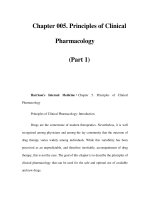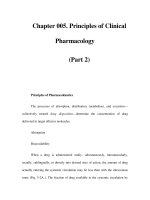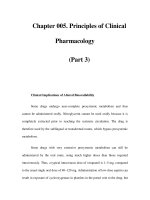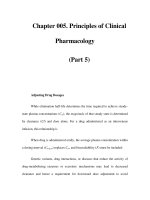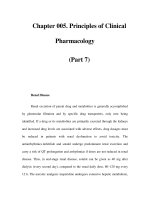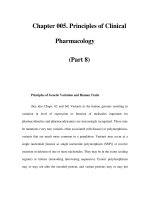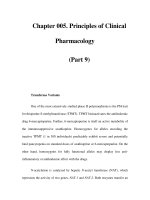Chapter 081. Principles of Cancer Treatment (Part 4) pdf
Bạn đang xem bản rút gọn của tài liệu. Xem và tải ngay bản đầy đủ của tài liệu tại đây (71.99 KB, 5 trang )
Chapter 081. Principles of
Cancer Treatment
(Part 4)
Palliation
Surgery is employed in a number of ways for supportive care: insertion of
central venous catheters, control of pleural and pericardial effusions and ascites,
caval interruption for recurrent pulmonary emboli, stabilization of cancer-
weakened weight-bearing bones, and control of hemorrhage, among others.
Surgical bypass of gastrointestinal, urinary tract, or biliary tree obstruction can
alleviate symptoms and prolong survival. Surgical procedures may provide relief
of otherwise intractable pain or reverse neurologic dysfunction (cord
decompression). Splenectomy may relieve symptoms and reverse hypersplenism.
Intrathecal or intrahepatic therapy relies on surgical placement of appropriate
infusion portals. Surgery may correct other treatment-related toxicities such as
adhesions or strictures.
Rehabilitation
Surgical procedures are also valuable in restoring a cancer patient to full
health. Orthopedic procedures may be necessary to assure proper ambulation.
Breast reconstruction can make an enormous impact on the patient's perception of
successful therapy. Plastic and reconstructive surgery can correct the effects of
disfiguring primary treatment.
Principles of Radiation Therapy
Physical Properties and Biologic Effects
Exposure to ionizing radiation is constant. Radiation comes from the sun
and other cosmic sources, the ground, the air we breathe, the food we ingest, and
from within our bodies. Radiation therapy uses radiation to treat cancer. Radiation
is a physical form of treatment that damages any tissue in its path; its selectivity
for cancer cells may be due to defects in a cancer cell's ability to repair sublethal
DNA and other damage. Radiation causes breaks in DNA and generates free
radicals from cell water that may damage cell membranes, proteins and organelles.
Radiation damage is dependent on oxygen; hypoxic cells are more resistant.
Augmentation of oxygen is the basis for radiation sensitization. Sulfhydryl
compounds interfere with free radical generation and may act as radiation
protectors.
Most radiation-induced cell damage is due to the formation of hydroxyl
radicals:
Ionizing radiation + H
2
O →H
2
O
+
+ e
–
H
2
O
+
+ H
2
O →H
3
O
+
+ OH˙
OH˙ →cell damage
The dose-response curve for cells has both linear and exponential
components. The linear component is from double-stranded DNA breaks produced
by single hits. The exponential component represents breaks produced by multiple
hits (Fig. 81-2). Plotting the fraction of surviving cells against doses of x-rays or
gamma radiation, the curve has a shoulder that reflects the cell's repair of sublethal
damage, followed by a linear portion reflecting greater cell kill with larger doses.
The features that make a particular cell more sensitive or more resistant to the
biologic effects of radiation are not completely defined.
Figure 81-2
Shape of survival curve for mammalian cells exposed to radiation.
The
fraction of ce
lls surviving is plotted on a logarithmic scale against dose on a linear
scale. For alpha particles or low-
energy neutrons (said to be densely ionizing), the
dose-
response curve is a straight line from the origin (i.e., survival is an
exponential function
of dose). The survival curve can be described by just one
parameter, the slope. For x-
rays or gamma rays (said to be sparsely ionizing), the
dose-
response curve has an initial linear slope, followed by a shoulder; at higher
doses the curve tends to become straight again. A.
The experimental data are fitted
to a linear-
quadratic function. There are two components of cell killing: one is
proportional to dose (αD), while the other is proportional to the square of the dose
(βD
2
). The dose at which the linear and quadratic components are equal is the
ratio α/β. The linear-
quadratic curve bends continuously but is a good fit to
experimental data for the first few decades of survival. B.
The curve is described
by the initial slope (D
1
), the final slope (D
0
), and a parameter that represents the
width of the shoulder, either n or D
q
.
(From EJ Hall: Radiobiology for the
Radiologist, 5th ed. Philadelphia, Lippincott Williams & Wilkins, 2000; with
permission.)

